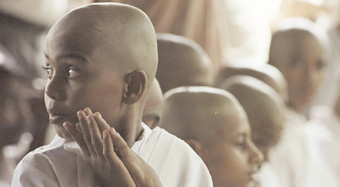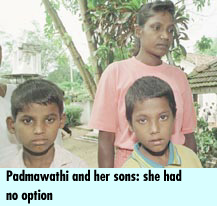 |
 30th May 1999 |
Front Page| |
 Now he is a sadhu |
Contents
|
|
 |
In the footsteps of the Buddha, 16 boys don the saffron robe at Vesak Now he is a sadhuBy Kumudini HettiarachchiThe scene was heart- breaking and poign- ant. Amidst pin-drop silence broken only by the stifled sobs of many a mother and a father, 16 young ones were bidding their final goodbye to their parents and in a sense to the material world. That would be the last time they would pay obeisance to their elders. Moments later it would be the other way round........all elders including their parents would pay their respects to these boys, aged between eight and 17. For they were to follow in the footsteps of the Buddha........renouncing all worldly pleasure and childish joy. This was a special occasion at the vihare on Walpola Road, Ragama— the ordination of 16 samaneras, who had come from villages off Akuressa to the south and Polonnaruwa to the north. The Sri Wimalarathnarama Vidyanivasa Pirivena set in a sprawling garden along the Kadurugahawewa was a hive of activity from about 6.30 a.m. last Monday. Hundreds of parents and relatives were gathered there to "give" their sons to the temple. They had come with their bags and other young children and camped in the pirivena hall. As the auspicious time drew near, there was an air of excitement tinged with tension and emotion. Only the mangy dogs and playful kittens in the temple compound seemed oblivious to this. Suddenly there was a rush towards the wewa. Down a small incline in an open space, buckets of water drawn from the well nearby were kept in readiness. On two simple benches were seated the samaneras-to-be, flicking off their "lay" shirts and banians. Saffron-robed monks, of all ages ranging from the very elderly to about nine years descended to the spot. Wetting each child's head thoroughly, the monks began soaping their hair. In the enthusiasm, the rivulets of soap were getting into the eyes of some boys, and a senior monk spotting their agony instructed the others to give them water to wipe them away. Now seated on the benches once again, the boys were handed over sheets of newspaper, amidst a call that the clock be brought from the temple. The papers were meant for the falling locks. Then the countdown began.....10 seconds.....five seconds......and 9.37 a.m. said the monk holding the clock, while 16 others stood above the boys with razors and "deli pihi" poised. It was time to shave their heads, while teaching them to meditate on the parts of the body by chanting....... "kesa, loma, natha, dantha, thacho" (hair, body hair, nails, teeth and skin), with a single lock of hair in their palms. An explosion of flashes as parents clicked their cameras. "Me deli pihiya kepenne ne" (This razor doesn't cut), says an elderly monk, easing the tangible tension, making the relatives laugh. Then one by one the head-shaven boys are led to the well, bathed tenderly and made to wear the white robes. The transition is immediately visible. They do not seem to be mischievous boys, but sedate "adults". Led in procession, to the sounds of bera, they take their place before the monks in the pirivena hall surrounded by relatives. It is time for them to pay their respects to their parents and the tears flow. At the auspicious time once again, "gatha" are recited and the senior monks hand over the "ata pirikara", the eight basic essentials the young samaneras will need, for their spartan existence. They are the "thani pata sivura" (the robe), "depeta sivura" (the cloth they will lay on the hard ground whenever they rest), "adanaya" (the under-garment), "paatraya" (the bowl to get alms), needle, reel of thread, "perahan kadaya" (the filtering cloth for water) and the "deli pihiya" (razor). Once again they are led away, this time to don the saffron-robe, making the transformation complete. Now they are samaneras. They come back for more chanting of "gatha", which they repeat line by line, faltering a little here and there over the Pali words and frequently looking back at their fathers, mothers, brothers and sisters........may be realising the irrevocable step just taken. Next they are given religious names suitable for samaneras. Before noon, also at the auspicious time of 11.40 a.m. it is time for them to partake of alms, brought in by those in the neighbourhood and also lovingly prepared by their relatives. With a tightness in my chest, I leave them solemnly wending their way to the "dane" and hear in the background the lisp of a little girl, "Amme dan aiya sadhu kenek neda." (Mother, brother is a sadhu now isn't he). A light shower begins to fall. Why do they join?The historic Walpola vihara, established over 100 years ago has been
a main centre of training for young samaneras. Every year, the pirivena
has seen at least 10 boys being ordained especially during
Front Page| News/Comment| Editorial/Opinion| Business| Sports | Mirror Magazine |
|
 |
Please send your comments and suggestions on this web site to |
|
 the
Vesak season or during a katina pinkama. Chief incumbent Kalugala Sri Sorathabidana
Mahanayake Thera says 79 novices and 20 lay children are studying at the
pirivena. It takes 20 years for the young samaneras to be ordained as monks
(receive "upa sampada"). Why do they join a monastery at such
tender ages? The query got different responses from different parents.
For Padmawathi Menike from Yamanakanda off Rambukkana it boils down to
simple economics. A mother of four between the ages of 6 and 12, her husband
died five months ago after an illness. Life is difficult. She toils daily
doing "kuli veda" to feed her hungry children. She and her children
live in a "watta" paying rent for their small hut. The maximum
she has earned in a "good" month is Rs. 1,000. She just does
not have the money to send her children to school. Someone in her village
suggested she "give" them to the temple. So here she was with
two of her sons — Nuwan (9) and Chaminda (11). They were among the samaneras
ordained on Monday. Padmawathi's eyes told a story which cannot be described
in words. Ten-year-old Madusanka "aasawenmai ave", says his father
G. Jayalath, a mason from Hakmana in Matara. Because he was a bright student
and they felt that the village school was not good, they sent him in February
to the pirivena to study. Seeing the young samaneras, he wanted to be ordained
too, his mother Sumithra says, adding, "I am very sad," pride
mingling with motherly love. "His mother who went to Kuwait two months
ago knows that he has agreed to become a samanera," says O.G. Gunatilleke,
peering over the shoulders of others at his nephew, Dilip Kumar, whose
head is being shaved. The boy's father is a farmer. There are two more
children in the family, back home in Parape, Rambukkana, who are being
looked after by the "punchi amma and achchi". It's a proud moment
for cinnamon-peeler K. Ariyadasa from Kohugoda in Akuressa. His eldest
boy, Sarath (15) is having his bath before the ordination ceremony. He
has two more children. Though after the ordination, the fond parents will
bid farewell to their sons with a heavy heart, they will be back every
month to see their progress. "That's certain," says Ariyadasa,
while the others nod in agreement.
the
Vesak season or during a katina pinkama. Chief incumbent Kalugala Sri Sorathabidana
Mahanayake Thera says 79 novices and 20 lay children are studying at the
pirivena. It takes 20 years for the young samaneras to be ordained as monks
(receive "upa sampada"). Why do they join a monastery at such
tender ages? The query got different responses from different parents.
For Padmawathi Menike from Yamanakanda off Rambukkana it boils down to
simple economics. A mother of four between the ages of 6 and 12, her husband
died five months ago after an illness. Life is difficult. She toils daily
doing "kuli veda" to feed her hungry children. She and her children
live in a "watta" paying rent for their small hut. The maximum
she has earned in a "good" month is Rs. 1,000. She just does
not have the money to send her children to school. Someone in her village
suggested she "give" them to the temple. So here she was with
two of her sons — Nuwan (9) and Chaminda (11). They were among the samaneras
ordained on Monday. Padmawathi's eyes told a story which cannot be described
in words. Ten-year-old Madusanka "aasawenmai ave", says his father
G. Jayalath, a mason from Hakmana in Matara. Because he was a bright student
and they felt that the village school was not good, they sent him in February
to the pirivena to study. Seeing the young samaneras, he wanted to be ordained
too, his mother Sumithra says, adding, "I am very sad," pride
mingling with motherly love. "His mother who went to Kuwait two months
ago knows that he has agreed to become a samanera," says O.G. Gunatilleke,
peering over the shoulders of others at his nephew, Dilip Kumar, whose
head is being shaved. The boy's father is a farmer. There are two more
children in the family, back home in Parape, Rambukkana, who are being
looked after by the "punchi amma and achchi". It's a proud moment
for cinnamon-peeler K. Ariyadasa from Kohugoda in Akuressa. His eldest
boy, Sarath (15) is having his bath before the ordination ceremony. He
has two more children. Though after the ordination, the fond parents will
bid farewell to their sons with a heavy heart, they will be back every
month to see their progress. "That's certain," says Ariyadasa,
while the others nod in agreement.